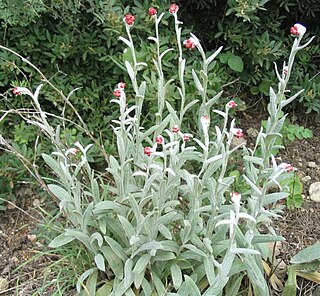
The genus Helichrysum consists of an estimated 600 species of flowering plants in the sunflower family (Asteraceae). The type species is Helichrysum orientale. They often go by the names everlasting, immortelle, and strawflower. The name is derived from the Anicent Greek words ἥλιος and χρῡσός.

Bucculatricidae or (Bucculatrigidae) is a family of moths. This small family has representatives in all parts of the world. Some authors place the group as a subfamily of the family Lyonetiidae.

Bucculatrix canadensisella, the birch skeletonizer, is a moth of the family Bucculatricidae. The species was first described by Vactor Tousey Chambers in 1875. It is found in North America. In Canada, it has been recorded from New Brunswick to British Columbia, Nova Scotia and Prince Edward Island. In the United States, it has been recorded from New York, New Jersey, Michigan, Wisconsin, Minnesota, Pennsylvania, North Carolina, Tennessee, Kentucky and Colorado.

Bucculatrix frangutella is a moth of the family Bucculatricidae. It was described by Johann August Ephraim Goeze in 1783. It is found in Europe.
Bucculatrix eucalypti is a moth of the family Bucculatricidae. It was described in 1880 by Edward Meyrick and is found in Australia.
Bucculatrix ivella is a moth of the family Bucculatricidae. It was described in 1900 by August Busck. It is native to North America, but has been introduced to Queensland, Australia.
Bucculatrix lassella is a moth of the family Bucculatricidae. It is found in Australia. It was first described in 1880 by Edward Meyrick.
Bucculatrix xenaula is a moth of the family Bucculatricidae. It is found in South Australia. It was described in 1893 by Edward Meyrick.
Bucculatrix parthenica is a moth of the family Bucculatricidae. It is native to Mexico, but was released in Queensland, Australia, as a biological control agent for Parthenium weeds. It was described by John David Bradley in 1990.

Bucculatrix cristatella is a species of moth of the family Bucculatricidae. It is found in most of Europe. It was described in 1839 by Philipp Christoph Zeller.
Bucculatrix thurberiella, the cotton leaf perforator, is a species of moth of the family Bucculatricidae. It was first described by August Busck in 1914. It is native to the south-western United States and northern Mexico. It is an introduced species in Hawaii.
Bucculatrix pyrivorella is a moth of the family Bucculatricidae. It is found in Japan, the Korean Peninsula and the Russian Far East. It was described in 1964 by Hiroshi Kuroko.
Bucculatrix artemisiella is a species of moth of the family Bucculatricidae. It is found in most of Europe. It was first described by Gottlieb August Wilhelm Herrich-Schäffer in 1855.

Bucculatrix albedinella is a moth species of the family Bucculatricidae and was first described in 1839 by Philipp Christoph Zeller. It is found in most of Europe.

Aphis gossypii is a tiny insect, an aphid ("greenfly") in the superfamily Aphidoidea in the order Hemiptera. It is a true bug and sucks sap from plants. It is a widely distributed pest of a variety of agricultural crops in the families Cucurbitaceae, Rutaceae and Malvaceae. Common names include cotton aphid, melon aphid and melon and cotton aphid.

Bucculatrix ulmella is a moth of the family Bucculatricidae. It is found in most of Europe, except the Iberian Peninsula, Slovenia and Bulgaria. It was first described in 1848 by Philipp Christoph Zeller.

Bucculatrix bechsteinella is a moth of the family Bucculatricidae. It was described by Johann Matthäus Bechstein and Georg Ludwig Scharfenberg in 1805. It is found in most of Europe, except Greece and Bulgaria.
Bucculatrix mirnae is a moth in the family Bucculatricidae. It is found in the Azapa Valley in northern Chile. The species was first described in 2012 by Héctor Vargas and Gilson R.P. Moreira.
This page is based on this
Wikipedia article Text is available under the
CC BY-SA 4.0 license; additional terms may apply.
Images, videos and audio are available under their respective licenses.






